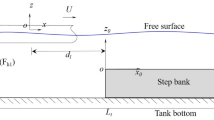Abstract
The coupled level-set and volume of fluid (CLSVOF) method is an advanced interface-capturing method that has been extended to handle overset grid systems. However, artificial uneven interface may be observed across block boundaries of different sizes and geometries. We present an improved inter-grid VOF interpolation and mass correction scheme to address the issue. To demonstrate the capability of the improved CLSVOF method, it is applied to the simulation of a container ship in pitch and heave motions under both head sea and following sea irregular wave conditions. Our simulation proves that the improved CLSVOF method is capable of revealing detailed physics difficult to see with other methods. Those phenomena simulated in our work include the extensive greenwater propagation on the ship deck, the breakup of overtopping waves into small droplets, and the formation and collapse of air pockets in sudden bow and stern slamming which cause strong and highly localized impacts on the ship bow, stern, and rudder.
Similar content being viewed by others
References
Chen H. C. Time-domain simulation of nonlinear wave impact loads on fixed offshore platform and decks [J]. International Journal of Offshore and Polar Engineering, 2010, 20(4): 275–283.
Chen H. C. CFD simulation of directional short-crested waves on jack-up structure [J]. International Journal of Offshore and Polar Engineering, 2013, 23(1): 38–45.
Zhao Y., Chen H. C., Yu X. Numerical simulation of wave slamming on 3D offshore platform deck using a coupled level-set and volume-of-fluid method for overset grid system [J]. Ocean System Engineering, 2015, 5(4): 245–259.
Chen H. C. CFD simulation of compressible two-phase sloshing flow in a lng tank [J]. Ocean System Engineering, 2011, 1(1): 29–55.
Zhao Y., Chen H. C. Numerical simulation of 3D sloshing flow in partially filled LNG tank using a coupled level-set and volume-of-fluid method [J]. Ocean Engineering, 2015, 104: 10–30.
Zhao Y. Chen H. C. Violent free surface flow simulations by a coupled level-set and volume-of-fluid method in overset grid systems [J]. International Journal of Offshore and Polar Engineering, 2014, 24(2): 114–121.
Zhao Y., Chen H. C. A new coupled level-set and volume-of-fluid method to capture free surface on an overset grid system [J]. International Journal of Multiphase Flow, 2017, 90: 144–155.
Sussman M., Puckett E. G. A coupled level set and volume-of-fluid method for computing 3D and axisymmetric incompressible two-phase flows [J]. Journal of Computational Physics, 2000, 162(2): 301–337.
Sussman M. A second order coupled level set and volume-of-fluid method for computing growth and collapse of vapor bubbles [J]. Journal of Computational Physics, 2003, 187(1): 110–136.
Jang W., Jilesen J., Lien F. S. et al. A study on the extension of a VOF/PLIC based method to a curvilinear co-ordinate system [J]. International Journal of Computational Fluid Dynamics, 2007, 22: 241–257.
Chen H. C., Chen C. R. An improved coupled level-set and volume-of-fluid method on overset grid systems and its application to extreme wave on a fixed offshore platform [C]. 30th International Offshore and Polar Engineering Conference, Shanghai, China, 2020, 2199–2206.
Chen C. R., Chen H. C. CFD simulation of bow and stern slamming on a containership in random waves [J]. International Journal Offshore and Polar Engineering, 2015, 25(3): 185–193.
Chen H. C., Yu K. Numerical simulation of wave runup and green water on offshore structures by a level-set rans method [C]. 16th International Offshore and Polar Engineering Conference, San Francisco, USA, 2006, 185–192.
Chen H. C., Yu K. CFD Simulation of wave-current-body interactions including greenwater and wet deck slamming [J]. Journal of Computers and Fluids, 2009, 38(5): 970–980.
Shu C. W. Essentially non-oscillatory and weighted essentially non-oscillatory schemes for hyperbolic conservation laws [R]. ICASE Report 97-65, NASA/CR-97-206263, 1997.
Gueyffier D., Li J., Nadim A. et al. Volume-of-fluid interface tracking with smoothed surface stress methods for three-dimensional flows [J]. Journal of Computational Physics, 1999, 152(2): 423–456.
Scardovelli R., Zalesaki S. Interface reconstruction with least-square fit and split Eulerian-Lagrangian advection [J]. International Journal for Numerical Methods in Fluids, 2003, 41: 251–274.
Wang Z., Yang J., Koo B. et al. A coupled level set and volume-of-fluid method for sharp interface simulation of plunging breaking waves [J]. International Journal of Multiphase Flow, 2009, 35: 227–246.
Miles M. D., Funke E. R. A comparison of methods for synthesis of directional seas [J]. Journal of Offshore Mechanics and Arctic Engineering, 1989, 111(1): 43–48.
Acknowledgements
This work was supported by the Ocean Systems Simulation and Control Laboratory (OSSCL) Consortium. The authors also gratefully acknowledge the computing resources provided by the High Performance Research Computing (HPRC) Center of Texas A&M University.
Author information
Authors and Affiliations
Corresponding author
Ethics declarations
This article does not contain any studies with human participants or animals performed by any of the authors.
Additional information
Conflict of interest
The authors declare that they have no conflict of interest.
Informed consent
Informed consent was obtained from all individual participants included in the study
Biography: Hamn-Ching Chen, Male, Ph. D., A. P. and Florence Wiley Professor I
Rights and permissions
About this article
Cite this article
Chen, HC., Chen, CR. CFD Simulation of a container ship in random waves using a coupled level-set and volume of fluid method. J Hydrodyn 35, 222–231 (2023). https://doi.org/10.1007/s42241-023-0019-x
Received:
Revised:
Accepted:
Published:
Issue Date:
DOI: https://doi.org/10.1007/s42241-023-0019-x




